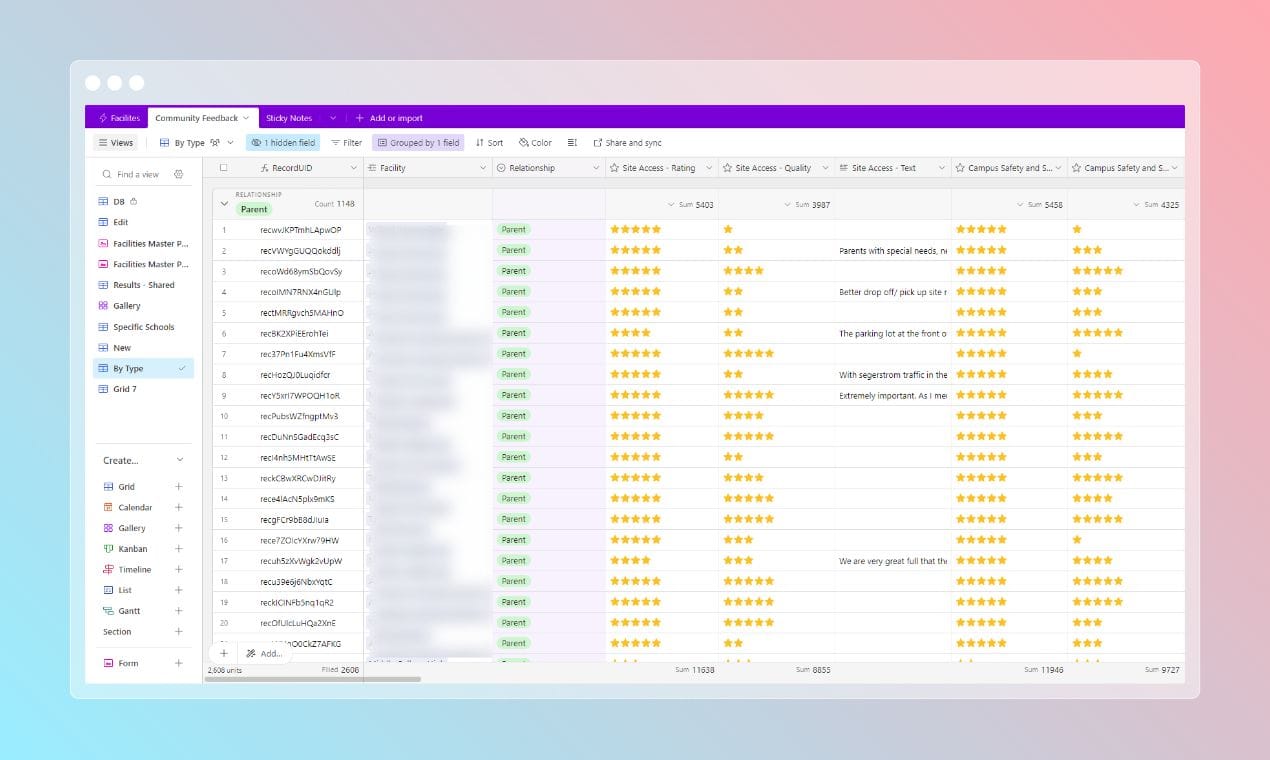Top 3 Strategies for Asking Effective Questions during K-12 Facilities Master Planning
It can be tricky to know what questions to ask during your community outreach. Here are my top 3 strategies.

Written by Josh Sanabria, CEO of GoArchitect.
Continuing my series on K-12 facilities master planning, I know it can be tricky to know what questions to ask during your community outreach. At GoArchitect, we have had the chance to work on 19+ master plans over the last 5 years. During that time we've developed 3 primary strategies for asking effective questions that drive healthy conversation and avoid the stereotypical pitfalls of public engagement
Here are my top 3 strategies for making sure you're asking the right questions from stakeholders.
Strategy 1: Know your Outreach Goals
Before you begin to ask your community questions or send them a survey, it's best to spend a few hours defining what goals you have for the outreach. Defining your goals will inform everything that comes next, the tools, questions, and methods.
Here are 3 example community outreach goals for K-12 facilities master plans.
Goal 1: Understand stakeholder's frame of mind and how they perceive the district and education within the district.
This first goal is the most general. How do people feel towards the district? Is there a natural trust or distrust? What historical events or current political situations effect how people respond to your outreach?
Goal 2: Understand stakeholder's specific feedback on the condition and performance of the campuses they interact with.
The second goal begins to narrow in on how people feel towards and interact with their campuses. Are their specific campus issues that need addressing? Do schools also function as community parks? Do people perceive the campus as safe? How well do drop-off and pick-up times perform?
Goal 3: Understand stakeholder's priorities and how these priorities may effect what construction projects they support.
The third goal puts the previous two into action. What projects should receive the most investment? How do these projects address the stakeholder's frame of mind and specific feedback? For example, if the playfields function as community parks after hours and the community recognizes this as important, will they prioritize funds to support this initiative vs another project?
Strategy 2: Use the Right Outreach Tools & Methods
Once you've defined your outreach goals, you can begin to shape the methods for gathering the information you need. There are countless tools on the internet to survey audiences; many are created with specific niches in mind.
What makes a good community engagement tool?
The best tools help you be more efficient and gather high-quality information. For example, doing a sticky note survey with physical sticky notes isn't necessarily bad but you are limited by the physical attendance of your meeting and the notes themselves can be lost, hard to read, or hard to track who said what.
You need tools that expand your reach, can be used for diverse audiences, and keep your data safe.
Here are 3 great community engagement tools.
Tool 1: Engage
Engage is an online community engagement survey tool designed specifically for master planning professionals. It was borne out of the needs that we observed across dozens of projects.
For example, Engage takes the classic sticky note feedback gathering approach and moves it online to gather subjective feedback from many stakeholders, at once; you'll never have to print another board again.
Obviously, I've slightly biased since I'm one of the creators of Engage. All I can say is that we built it to address the challenges we faced partnering with architecture firms and schools districts on 19+ K-12 facilities master plans. There is no other tool quite like it and we are always improving it.
Engage is free to use and you can learn more about it here.
There is also this in-depth article about using Engage for K-12 facilities master planning.

Tool 2: Tally
Tally is an incredible tool for building online surveys. It has a friendly user interface where you create your survey almost like writing a document. You can add images, text, and even complex routing.
I highly recommend Tally if you have a potentially very long or complex text-based survey. It doesn't have things like sticky notes or other "master plan" driven tools but it is the best of the best when it comes to online survey creation.

Tool 3: Airtable
Airtable is a fantastic tool for managing data. You can think of it like Excel or Google Sheets but more for data management. It is very user friendly and can even serve as the database for information capture using Engage or Tally.
You can think of Airtable as a one-stop-shop for data. You can use it to create surveys, host project information, or even as a spreadsheet tool for costs and calcs.
Strategy 3: Ask the Right Questions
Last but certainly not least, once you've defined the goals, asking the right questions sets the stage for accomplishing them.
I'm sure you've heard it before but the best questions are not yes/no questions.
The best questions play double-duty and help you accomplish more than one outreach goal at once. They also build on each other to help construct a cohesive output while also being mutually exclusive.
When you're drafting your questions keep the MECE principle in mind.
MECE = Mutually Exclusive Collectively Exhaustive
MECE suggests that when categorizing or dissecting information, each category should be distinct from the others (mutually exclusive) and together they should cover all possible options (collectively exhaustive).
This method helps avoid overlap and ambiguity, making your outreach efforts more effective and ultimately more powerful because you can prove support for your goals and initiatives.
Here are some questions I typically include.
- What campus are you connected with?
I begin with this question because it is usually a softball question. People typically are taking the survey for only one school.
Do not ask people to select more than one campus. If they have multiple children, they can take the survey again and select a different campus. - How are you connected to this campus?
Respondents can identify as a parent of a current student, staff member, current student, or general community member. It's important to gather this basic demographic information because we may want to prioritize feedback coming from parents and students over general community members. - How satisfied are you with the current condition of ________? Rate from 1-5.
This question is open ended to allow for a rating vs a yes/no response. Instead of asking, "Are you happy with____" we create the opportunity for a gradient response.
This not only gathers the subjective feedback of the individual but the qualitative feedback of what campus items might need the most attention. - What feedback do you have for district leadership about your campus?
This question is perfect for an Engage sticky notes survey. You can ask an open-ended and subjective question to gather feedback on campus items that an outsider wouldn't know.
Using Engage, we can also allow people to leave different color sticky notes. I typically use 1-3 colors.
Red: Urgent Needs
Blue: Great things about this campus.
Yellow: General Feedback
Using Engage, you can also choose to share this feedback using a results dashboard that show all of a site's sticky notes. - How would you prioritize the following projects?
This question is perfect for an Engage action dots survey which allows participants to rate proposed projects on a site from 1-5 stars. These ratings quantifiably help you build or prove support for certain initiatives.
Combined with a the demographic questions, you can see who is prioritizing which types of projects. This is powerful information for deciding what costs to plan for in a general obligation bond. - Want to be updated when the master plan is approved? Provide your email below.
I typically make the final question an email question. Asking for emails not only gathers contact info but also increases response quality since people think they may be asked about their response. This question can be made optional.
Setup a 30-min free call with me
I hope this article has been helpful for your master planning efforts. If you or your teams need help with an upcoming master plan, I'm available to jump on a video call and talk logistics, strategy, and anything else that can be helpful to you.



